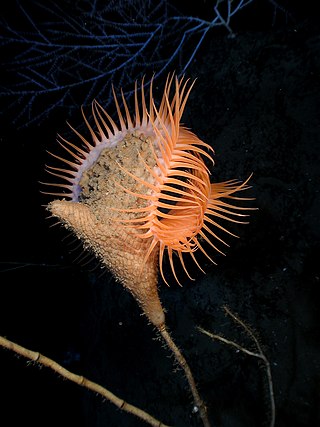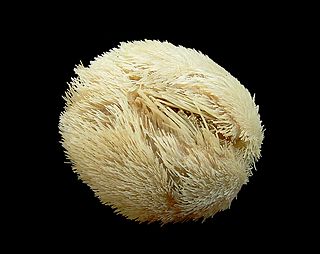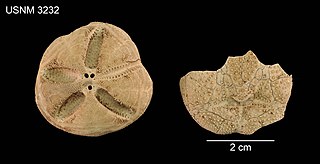
Sea urchins or urchins are typically spiny, globular animals, echinoderms in the class Echinoidea. About 950 species live on the seabed, inhabiting all oceans and depth zones from the intertidal to 5,000 metres. Their tests are round and spiny, typically from 3 to 10 cm across. Sea urchins move slowly, crawling with their tube feet, and sometimes pushing themselves with their spines. They feed primarily on algae but also eat slow-moving or sessile animals. Their predators include sea otters, starfish, wolf eels, and triggerfish.

An abyssal plain is an underwater plain on the deep ocean floor, usually found at depths between 3,000 and 6,000 metres. Lying generally between the foot of a continental rise and a mid-ocean ridge, abyssal plains cover more than 50% of the Earth's surface. They are among the flattest, smoothest, and least explored regions on Earth. Abyssal plains are key geologic elements of oceanic basins.

The Aspidodiadematidae are a family of sea urchins.

The Venus flytrap sea anemone is a large sea anemone that superficially resembles a Venus flytrap. It closes its tentacles to capture prey or to protect itself. It is a deep ocean species.

The Bear Seamount is a guyot or flat-topped underwater volcano in the Atlantic Ocean. It is the oldest of the New England Seamounts, which was active more than 100 million years ago. It was formed when the North American Plate moved over the New England hotspot. It is located inside the Northeast Canyons and Seamounts Marine National Monument, which was proclaimed by President of the United States Barack Obama to protect the seamount's biodiversity.

The Echinothurioida are an order of sea urchins in the class Echinoidea. Echinothurioids are distinguished from other sea urchins by the combination of a flexible test and hollow spines. The membrane around the mouth contains only simple plates, in contrast to the more complex mouth parts of their close relatives, the Diadematoida. They are nearly all deepsea dwellers.

Cidaridae is a family of sea urchins in the order Cidaroida.

Echinocardium cordatum, also known as the common heart urchin or the sea potato, is a sea urchin in the family Loveniidae. It is found in sub-tidal regions in temperate seas throughout the world. It lives buried in the sandy sea floor.

Asthenosoma marisrubri, aka Red Sea fire urchin and toxic leather sea urchin , is a relatively common sea urchin with a widespread distribution in the Indo-Pacific, and was till 1998 considered a color variant of Asthenosoma varium. Sea urchins are close relatives of starfish, crinoids, brittle stars and sea cucumbers, all being echinoderms.

Abatus cordatus is a species of sea urchin in the family Schizasteridae. It is native to shallow seas surrounding certain island groups in the southern Indian Ocean. The body is protected by a hard test or shell which is covered with spines. The female broods its young in deep pockets on the upper surface, retaining the young in place with specialised spines. American zoologist Addison Emery Verrill first scientifically described A. cordatus in 1876.
Aspidodiadema jacobyi is a small sea urchin in the family Aspidodiadematidae. It lives in tropical seas at great depths. Aspidodiadema jacobyi was first scientifically described in 1880 by Alexander Emanuel Agassiz, an American scientist.
Calveriosoma gracile is a species of sea urchin in the order Echinothurioida. It is a deep water species and is found on the seabed in western parts of the Pacific Ocean at depths of 200 to 800 metres.

Phormosoma placenta is a species of sea urchin in the order Echinothurioida. It is a deepwater species, seldom being found at depths less than 500 m (1,600 ft), and occurs on either side of the Atlantic Ocean on the continental slope.

Cidaris blakei is a species of sea urchins of the family Cidaridae. Its armour is covered with spines of three types, one unique type being extended and fan-like, making it easily recognized. Alexander Agassiz first described it scientifically in 1878. It is present on the seabed in deep waters in the Gulf of Mexico and the Bahamas.

Astropecten duplicatus, the two-spined sea star, is a starfish in the family Astropectinidae. It is found in the eastern Atlantic Ocean, the Caribbean Sea and the Gulf of Mexico.

Diadema savignyi is a species of long-spined sea urchin belonging to the family Diadematidae. Common names include long-spined sea urchin, black longspine urchin and the banded diadem. It is native to the east coast of Africa, the Red Sea, the Indian Ocean and western Pacific Ocean. It was first described in 1829 by the French naturalist Jean Victoire Audouin. The specific epithet honours the French zoologist Marie Jules César Savigny who described many new marine species from the Mediterranean Sea and Red Sea. The type locality is Mauritius.

Molpadia musculus is a species of sea cucumber in the family Molpadiidae. It is found in deep waters in the Atlantic Ocean, burrowing in the mud.

Leodia sexiesperforata, commonly known as the six-holed keyhole urchin, is a species of sand dollar, in the echinoderm order Clypeasteroida. It is native to tropical and sub-tropical parts of the western Atlantic Ocean where it buries itself in soft sediment in shallow seas.

Pourtalesia is a genus of the family Pourtalesiidae which belongs to the irregular sea urchins. The animals measure 5–6 cm in length and live in the abyssal zone of the Atlantic, Pacific, Indopacific and Antarctic Oceans where they have been found in more than 3,000 m depth. The mouth opening of these animals is located anteriorly and the lantern of Aristotle is missing as typically for holasteroid sea urchins.

Goniocidaris umbraculum is a species of cidaroid sea urchin that inhabits the continental shelf off the southern coasts of New Zealand. It is plentiful on a seabed composed of seashell and bryozoan rubble at a depth of 95 m (310 ft) off Otago.


















